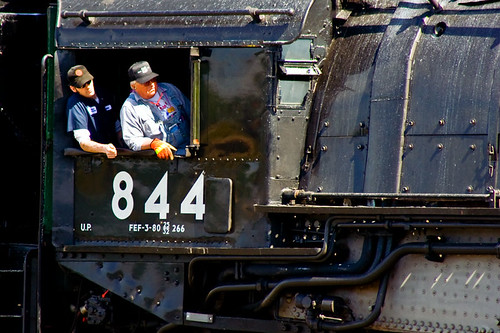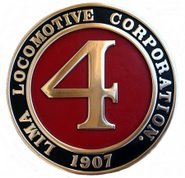
I haven't cooked lunch for the crew at the engine house of the El Dorado Western Railway in six months. Several priority projects kept me from cooking in the months leading to my early June departure for the summer camp job. My labor was more important at that point.
Railway President
Keith Berry and I first discussed a lunch meal several weeks ago. We both wanted to reward the crew for a summer of notable accomplishments. Plus several out-of-town volunteers were driving in for the day.
Twice this summer, Keith called on the volunteers to complete high-profile projects in a short period of time. Last June the crew rallied to remove the rail, tie plates and rail joiners from the old Southern Pacific yard at Diamond Springs. Once the county gave its approval to remove the track and associated hardware, we had less than two weeks to complete the job.
The crew completed the project in eight days. Several volunteers worked every day. The rails and hardware will be used to add a third rail and build the yard at the recently approved El Dorado County Historical Railroad Park in the town of El Dorado.
The most noteworthy event of the summer came on August 25 when the El Dorado County Board of Supervisors approved the park on a 5-0 vote. The park will be located on the right-of-way of the Southern Pacific depot in El Dorado.
Volunteers again answered the call this weekend when it became evident that we had to move about 300 ties to a secure location. The ties were open to theft in their current location along the old right-of-way, which is being converted into a riding and walking trail.
Lunch at the engine houseI often use meals at the engine house to try new recipes and to use ingredients that I already have at home. Since I had a 4-pound pork shoulder in the freezer, I knew the menu would be built around a pork dish.
Although chili verde is a favorite -- a dish I enjoy cooking for potlucks -- I wanted to try a flavor combination that was new for me. The idea for a pork stew came to me as I watched Alton Brown's
Good Eats television show last week.
In the re-broadcast of his 2005 "Dis-Kabob-Ulated" episode, Brown marinated beef sirloin in a spicy marinade with red wine vinegar and olive oil. Turmeric, smoked paprika and cumin formed the flavor base for the marinade.
Since it isn't practical to make pork kabobs with the tougher pork shoulder, a braised or stewed dish seemed to be the best way to tenderize the meat. I used the marinade to impart flavor, then prepared a tradition stew from that point.

I worked the recipe in my mind Friday evening as I moved railroad ties. I had originally planned to work out the menu and shop that evening. But a 3 p.m. telephone call from Keith brought me to the Diamond Springs yard instead.
When I arrived at the storage site for the ties, the crew (
Mark Bruto,
Ed Cunha, Keith and myself) asked me what was on the lunch menu for Saturday. I received a chuckle or two when I told them that Keith had pulled me away from my menu planning duties.
They weren't amused when I said that I should be home planning the menu. At that moment, the crew was more interested in my back than culinary skills. Since we didn't quit until 7:30 p.m., I delayed shopping until Saturday morning.
My original thought was to prepare the stew with orange marmalade, but hit on the idea to build the stock with apple juice after moving almost 250 ties. Yams and apples seemed like a natural addition from that point.
Here's the menu for the El Dorado Western Railway lunch (the links take you to
'Round the Chuckbox, my personal blog):
Eleven crew and guests enjoyed the meal. While I cooked,
Doug Youngberg,
Sam Thompson,
Bill Rodgers, Mark and Keith (see picture) loaded the 1937 Waukesha engine from the Diamond and Caldor railbus onto Doug's trailer. Doug will rebuild the six-cylinder engine and return it to the museum next spring.
After lunch, Ed drove over to the
Diamond Springs-El Dorado FPD Station 49 to pick up the fire department's Bobcat. The crew (
Bill Schultz,
Allen Key,
Jacob Karoly,
Wayne Thorely, Mark, Keith, Ed and myself) headed over to the Diamond Springs yard. The last 40 or 50 ties, including about 15 massive switch ties, had to be moved to secure storage.
Keith then asked if I was going to help. Lunch over, it was time to get back to work.
 After completing the rear truck project, Doug took his grandsons inside the engine house to work on the Diamond and Caldor No. 4 Shay locomotive. Here Breck (center) uses a die to thread one of eight eye bolts on the brake safety system while Andy observes. There are eight brake safety chains on the Shay, each with two eye bolts. A pair of chains hold each of four massive brake beams in place in the event of a failure.
After completing the rear truck project, Doug took his grandsons inside the engine house to work on the Diamond and Caldor No. 4 Shay locomotive. Here Breck (center) uses a die to thread one of eight eye bolts on the brake safety system while Andy observes. There are eight brake safety chains on the Shay, each with two eye bolts. A pair of chains hold each of four massive brake beams in place in the event of a failure. Ed helps his granddaughter clean one of the differential yokes from the rear truck to the railbus. Ed completed a major re-build of the Camino, Placervile and Lake Tahoe No. 4 track inspection car (in the background) in 1999.
Ed helps his granddaughter clean one of the differential yokes from the rear truck to the railbus. Ed completed a major re-build of the Camino, Placervile and Lake Tahoe No. 4 track inspection car (in the background) in 1999. My son, Jacob, scrapes and brushes 30 years of encrusted grease off the railbus. He put his slender frame to work inside the transmission compartment. The engine and transmission were removed last spring for a complete re-build.
My son, Jacob, scrapes and brushes 30 years of encrusted grease off the railbus. He put his slender frame to work inside the transmission compartment. The engine and transmission were removed last spring for a complete re-build.
















































 John screws one of the top plates onto the studs for the cab.
John screws one of the top plates onto the studs for the cab.



